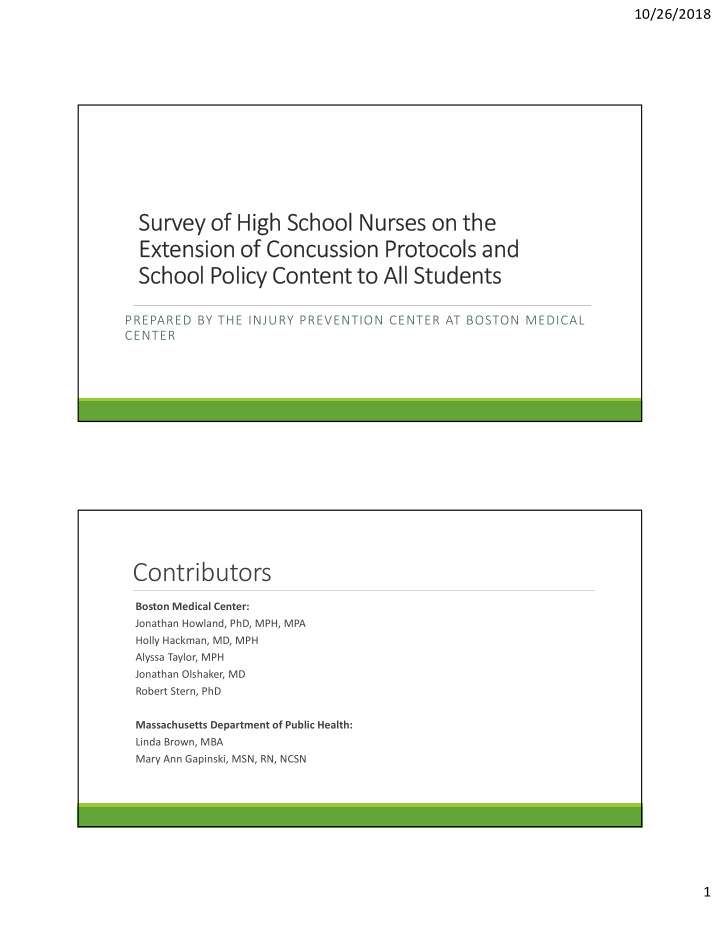



10/26/2018 Survey of High School Nurses on the Extension of Concussion Protocols and School Policy Content to All Students PREPARED BY THE INJURY PREVENTION CENTER AT BOSTON MEDICAL CENTER Contributors Boston Medical Center: Jonathan Howland, PhD, MPH, MPA Holly Hackman, MD, MPH Alyssa Taylor, MPH Jonathan Olshaker, MD Robert Stern, PhD Massachusetts Department of Public Health: Linda Brown, MBA Mary Ann Gapinski, MSN, RN, NCSN 1
10/26/2018 Background BMC Evaluators, as part of MDPH’s Core Violence and Injury Prevention Program funding, conducted 4 focus groups in 2015 with School Nurses (2) and Athletic Trainers (2) to examine local implementation of the state’s 2011 sports concussion regulations An unexpected finding, and perhaps unanticipated consequence of the law, was that many School Nurses had generalized regulations to all students (including non-athletes), regardless of where and how the concussion had occurred MA Regulations state that school policies “may be applied to all head injuries in students” A quantitative survey was needed determine the extent to which they are applying the sports concussion regulations to all of their students, not just those participating in school athletics Methods Randomly sampled half of MA’s public and private schools with 100 or more students enrolled in grades 9 and higher Electronic survey to sampled school nurses distributed through regional nurse coordinators Fall 2016 -early Winter 2017 2
10/26/2018 Survey Content School characteristics Whether school nurses applied the return to play and academics and medical clearance requirements of the regulations in their nursing practice to ALL STUDENTS with concussion regardless of where or how the head injury occurred (vs. just those with concussions in extracurricular sports vs. “other”) Whether their school’s policy requires protocols for graduated return-to-play and academics and medical clearance for ALL STUDENTS who have had a confirmed concussion, regardless of where or how the head injury occurred (vs. just those with concussions in extracurricular sports) Rating (Scale 0-10) on extent the implementation of the regulations added to their workload Rating (Scale 0-10) on importance of the regulations in protecting the health and safety of their students Findings 227 schools in final sample (47 private, 180 public) 168 respondents completed questions pertaining to the main measures (response rate 74%) 94.0% (158/168) applied these protocols to ALL high school students with a confirmed concussion regardless of where or how the injury occurred With exception of school size (school with up to 250 students less likely than larger schools), NO statistically significant differences in the expansion of these protocols by school attributes 77.4% (130/168) indicated their school policy required protocols in these areas for ALL students Extent to which the implementation added to the workload : Median 5 (Scale 0-10) Extent of their belief in the importance of the regulations in protecting the health and safety of students : Median 10 (Scale 0-10) 3
10/26/2018 Conclusions and Next Steps Almost all MA high schools with enrollments >100 are generalizing the return to play and learn requirements and the medical clearance requirements to all students with confirmed concussion, and most of these schools have codified this practice within their policies. These findings also have important clinical and academic implications that pertain to teachers, parents, students and clinicians MA legislation and/or regulations should be amended to reflect practice and ensure all students benefit equally (specifically: return-to-learn) Area for additional research: ◦ Review specifics of practices and policies to aid interpretation New Survey Being Conceptualized Examining the extent to which baseline neurocognitive testing is being conducted by the schools ◦ Mechanism for testing ◦ Requirement for testing ◦ Type of testing ◦ Who is being tested 4
Recommend
More recommend